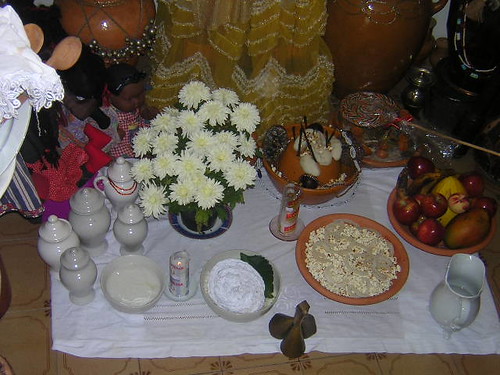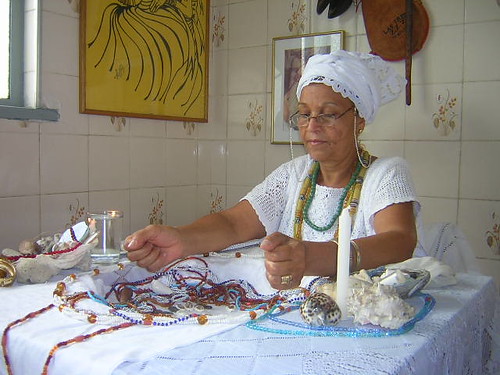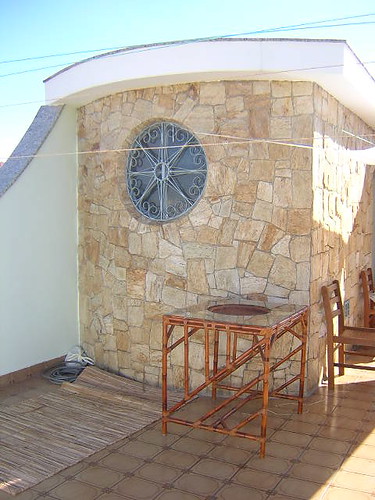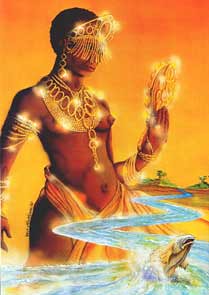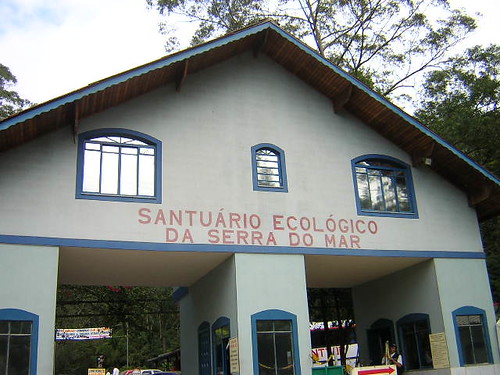
Santuario Ecologico da Serra do Mar, São Paulo. (Para português, olha embaixo.) Today I participated in my third Candomblé ritual. Over the last several months I have been learning slowly, but surely, about the practice of Candomblé, the Afro-Brazilian religion I mentioned in my February 9 entry. I am learning from a mãe de santos, Augusta Assuncao, and her husband, Raul, who has written a book on one of the orixas. After having read a few books before arriving here, checking out some articles and books here, taking an herbal bath at home (to revive my spirits) prepared by Augusta, completing an extensive interview with Augusta in March, finally I began as a participant-observer (an anthropological term that describes researchers who learn by involving themselves in a community). It was in April that I put on the traditional candomble whites (see the photos) and entered the prayer room (Roncó) for the first time. Last week, I helped in the semi-annual cleaning of the orixas altars (Osse). And, finally, this weekend, I journeyed to a ritual ground to give offerings to the orixas.
We got up relatively early this Sunday... at about 8 a.m. to then meet with everybody at Augusta´s house at about 9. All 12 or so of us packed into a small school bus and car and headed out to the state park outside the city of São Paulo. The ritual ground was indeed private property in the middle of the state park. And, interestingly, it was actually for Umbanda, a similar Afro-Brazilian religion that has a lot more syncretism or elements of Christianity mixed in. The orixas (African spirits representing different aspects of a monotheistic supreme power), however, are shared in Umbanda and Candomble. The ritual ground, called ´Santuário Ecológico da Serra do Mar,´ is made up of acres of land lush with natural and planted greenery. There are several open-air temple spaces available to different groups and accessable after the snack shop and parking lot. In the middle of the long line of formal ritual spaces, there is a plaza of statues of the orixas where people give offerings and pray. After that, you hike along a path and get to the most important part of the place – the waterfalls. It is here where people cleans themselves spiritually and where many smaller groups have their rituals.
We set up our offerings of what I think vatupa (I think) and madioca covered in dende (palm oil... important to Candomblé and people of the northeast Brazil), flowers, perfumes, and candles. Augusta cleansed everybody individually with pipoca seeds and prayed to the orixas for our personal well-being. We then gathered around the offerings, and sang songs to the orixás in Yoruba. I tried to sing along, but mostly marveled in how much we sounded like the groups of Africans singing in all of those films like Jardim Fiel. It was beautiful to hear. Then an orixá incorporated (possessed) Augusta, led us in more songs, and gave blessings. This part of the ritual is considered the most sacred. Raul advised me I should not take pictures. In that spirit, I think I should hold off on relating this part of the day, though I can say it was powerful for everyone there. (No worries to those of you who might not know about Candomblé... though the Catholic church did well to vilanize it and relate everything in it to Satan, it is a peaceful and positive religion. There are no intential uses of bad energy or “magic.”) After the orixa left Augusta, we took invidual trips to the waterfall. The brave ones got completely wet. I only walked up to the water, hoping to avoid wet hair in cold weather since I have had a the remains of a cold for more than two months (yes, I know, I need to go to the doctor).
We then headed back to get some snacks before our 45 minute drive back to the heart of the city. I left feeling tired not because of the ritual, but because of the early rise. I like my late weekend mornings! But more than tired, my mind was busy processing everything I had been learning about Candomblé. Really, I have much more to learn... but I am so glad to have this opportunity to see it up close.
------------
Santuario Ecologico da Serra do Mar, São Paulo. Hoje eu participei em meu terceiro ritual de Candomblé. Sobre o último diversos meses eu tenho aprendido lentamente, mas certamente, sobre a prática de Candomblé, a religião afro-brasiliera que eu mencionei em minha entrada de 9 de fevereiro. Eu estou aprendendo de um mãe de santos, Augusta Assunçao, que é a tia do Lucas (que sorte para mim) e seu marido, Raul, que escreveu um livro dum orixa. Em seguida lendo alguns livros antes de chegar aqui e alguns artigos e livros aqui, fazendo um banho de herves no repouso (para revive meus espíritos) preparado por Augusta, terminando uma entrevista extensiva com a Augusta em março, finalmente eu comecei como um participante-observador (um termo de antropologia que descreve os investigadores que aprendem se envolvendo em uma comunidade). Realizava-se em abril que eu vesti as ropas brancas e tradicionais de Candomble (veja as fotos) e entrei no quarto do rezar (Roncó) para a primeira vez. Última semana, eu ajudei na limpeza semi-anual dos alteres dos orixas (Osse). E, finalmente, este fim de semana, eu viajei a uma terra ritual para dar oferendas aos orixas.
Nós levantamo-nos relativamente cedo este domingo... a aproximadamente 8h a então encontramo-nos com todos na casa de Augusta em aproximadamente 9h. Doze ou assim pessoas embalaram em uma ônibus pequeno e em um caro e dirigem ao parque de estado fora da cidade de São Paulo. A terra ritual era certamente propriedade confidencial no meio do parque de estado. E, interessante, era realmente para Umbanda, uma religião afro-brasiliana similar que tem muito mais o syncretismo ou os elementos do cristianismo misturado dentro. Os orixás (espíritos africanos que representam aspectos diferentes de um poder único e supremo), entretanto, são compartilhados em Umbanda e em Candomble.
A terra ritual, chamada 'Santuario Ecologico da Serra do Mar,' é composto dos acres da terra muito verde e nativa. Há diversos espaços e templos de ar livre disponíveis aos grupos diferentes que ficam após a loja do lanches e o lote do estacionamento. No meio da linha longa de espaços ritual formais, há uma praça das estátuas dos orixas onde os povos dão oferendas e reza. Mas após todos os espaços rituais formais, você anda acima ao longo de um trajeto e começa à parte a mais importante do lugar - as cachoeiras. É aqui onde as pessoas se limpam espiritualmente e onde muitos grupos menores têm seus rituais.
Nós arrumamos nossas oferendas de vatapa (eu penso) e do madioca coberto no dende (óleo de palma... importante para Candomblé e povos do Brasil do nordeste), nas flores, nos perfumes, e nas velas. Augusta limpou todos individualmente com sementes da pipoca e rezou aos orixás para nosso bem estar pessoal. Nós recolhemos então em torno das oferendas, e cantamos canções aos orixas em Uruba. Eu tentei cantar sem conseguindo, mas maravilhei-me na maior parte em quanto nós soamos como os grupos dos africanos que cantam em todas aquelas películas como Jardim Fiel. Era bonito ouvir-se. Então um orixa incorporou Augusta, conduziu-nos cantar mais canções, e deu orações. Esta parte do ritual é considerada o mais sacrado. Raul recomendou-me que eu não devo tirar fotos. Neste espírito, mim pensa eu devo prender fora em relacionar esta parte do dia, embora eu posso dizer que era poderosa para todos lá. (Nenhum se preocupa àqueles de você que não pôde saber sobre Candomblé... Apesar de a igreja catholica fêz bem falar mal de Candomblé e relacionou tudo nele ao Diabo, é uma religião calma e positiva. Não há usa de energia negativa ou da "mágica má.") Depois que o orixa deixou o corpo de Augusta, nós fizemos viagems inviduais as cachoeira. Bravos começaram completamente molhados. Eu andei somente até a água, esperando evitar o cabelo molhado no tempo frio desde que eu estava ainda com gripe para mais de dois meses (sim, eu sei, mim necessito ir ao doutor).
Nós dirigimos então para trás para começar alguns lanches antes que nossos 45 movimentação minuciosa para trás ao coração da cidade. Eu deixei o sentimento cansado não por causa do ritual, mas por causa da ascensão adiantada. Eu gosto de minhas manhãs atrasadas do fim de semana! Mas cansado mais do que, minha mente era ocupada processar tudo que eu tenho aprendido sobre Candomblé. Realmente, eu tenho muito mais a aprender... mas eu sou assim que contente de ter esta oportunidade de vê-la bem pertido.
